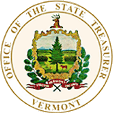Montpelier VT – State Treasurer Mike Pieciak’s office hosted its second “Climate Finance Roundtable,” convening national and local leaders from across sectors to strengthen coordination in securing and deploying federal funding for climate infrastructure and resilience projects in Vermont.
The discussion highlighted the potential implications of the 2024 election on federal funding opportunities, the critical role of resilience investments in supporting flood recovery, and innovative strategies to overcoming challenges faced by Vermont’s small towns. Speakers included state government officials and representatives from Bloomberg Philanthropies, the Government Finance Officers Association (GFOA), the Climate Action Office, USDA Rural Development, the Vermont Bond Bank, and other key organizations.
The Treasurer’s Office is hosting the roundtable series in response to 2023 legislation seeking to improve coordination in securing climate infrastructure funding resources and to establish a framework for cross-sector collaboration.
Deputy Treasurer Gavin Boyles said, "Treasurer Pieciak and I are so pleased to convene these roundtables; they are emblematic of Vermonters’ collaborative and thoughtful approach to one of Vermont’s most complex and long-term fiscal issues. Yesterday’s event comes shortly after a consequential federal election, and our national and federal speakers provided real insight on how to move forward here in Vermont."
The 2024 election has created particular uncertainty around the future of the Inflation Reduction Act (IRA), a cornerstone of the Biden Administration's climate and energy agenda. This uncertainty for IRA programs like Elective Pay, which provides partial rebates for eligible clean energy projects upon completion, may discourage eligible entities from pursuing funding.
Emily Brock, Director of GFOA’s Federal Liaison Center, shared insights based on her experience navigating federal funding shifts across administrations. She emphasized that obligated funds are generally secure and reassured participants that the legislative process for dismantling portions of the IRA like Elective Pay would help provide advance warning, in which case advocacy would be critical.
As uncertainties around the IRA crystallize, many speakers emphasized prioritizing resilience investments to mitigate the impacts of flooding and extreme weather. Such investments, like those made after Tropical Storm Irene to protect the Waterbury State Office Complex, pay off $6 for every $1 invested, according to FEMA data relayed by Doug Farnham, the State’s Chief Recovery Officer.
Michael Gaughan, Executive Director of the Vermont Bond Bank, highlighted a new $40 million financing facility through the USDA’s Rural Energy Savings Program. The initiative offers low-interest loans to Vermont municipalities and school districts for energy projects that reduce costs and combat climate change, benefiting rural communities statewide. Sarah Waring, the State Director for USDA Rural Development, provided first-hand observations about the coming transition, and about the ongoing availability of non-FEMA funds, including from USDA.
Chief Recovery Officer Doug Farnham and Hazard Mitigation Officer Stephanie Smith provided updates on Vermont’s flood recovery efforts. They outlined the State’s resilience-related priorities, including property buyouts in flood-prone areas, conservation planning, and investments in housing and natural infrastructure. They also stressed the need for regional collaboration among municipalities and clear frameworks for long-term community rebuilding and resilience.
Speakers also discussed successful methods aimed at improving Vermont communities’ capacity to secure and deploy federal funds. Luke McGowan of Bloomberg Philanthropies gave an overview of the organization’s “Infrastructure Hub,” which offers educational webinars, training workshops, and valuable resources for communities of all sizes.
Morgan Hood from Vermont Gas Systems demonstrated a new AI tool VGS developed to help Energy Navigator volunteers highlight federal incentives that can support weatherization and home energy improvements. Emma Spett of UVM’s Institute of Rural Partnerships also outlined a potential new collaboration to provide additional capacity to communities across the State.
As these and other funding opportunities and programs evolve, the Treasurer’s Office will continue working to expand access to federal programs and develop innovative funding strategies to support key resilience investments statewide. Significant funding opportunities remain available worth well over $100 million to the State, including initiatives for solar, home energy improvements, and vehicle electrification, among others.
You can learn more about the Treasurer’s climate infrastructure financing efforts here.
###





